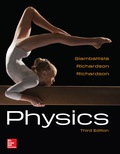
Concept explainers
(a)
The velocity of pan just after the landing of oranges.
(a)
Answer to Problem 112P
The velocity is
Explanation of Solution
The spring constant is
Write the equation for law of conservation of energy for the fall of oranges.
Here,
Rewrite the above equation in terms of
Write the equation for law of conservation of momentum for before and after the landing of oranges on pan.
Here,
Conclusion:
Substitute
Substitute
Therefore, the velocity is
(b)
The new equilibrium point of pan with oranges from the position before the oranges was dropped.
(b)
Answer to Problem 112P
The distance to new equilibrium point is
Explanation of Solution
The spring constant is
Write the equilibrium condition for the old equilibrium point.
Here,
Write the equation for new equilibrium on adding certain amount of mass.
Here,
Conclusion:
Substitute
Therefore, the distance to new equilibrium point is
(c)
The amplitude of the oscillations.
(c)
Answer to Problem 112P
The amplitude is
Explanation of Solution
The spring constant is
Write the equation for law of conservation of energy.
Here,
Write the equation for
Write the equation for
Write the equation for
Rewrite equation (I) by substituting equations (II), (III), (IV) and
Eliminate the common terms and rewrite the above expression in terms of
Conclusion:
Substitute
Therefore, the amplitude is
(d)
The frequency of oscillations of the system.
(d)
Answer to Problem 112P
The frequency is
Explanation of Solution
The spring constant is
Write the equation for the oscillations of a spring.
Here,
Conclusion:
Substitute
Therefore, the frequency is
Want to see more full solutions like this?
Chapter 10 Solutions
Physics
- 3aarrow_forward44 please help with the this.arrow_forward4a Which of the following values COULD NOT be a magnitude? Choose all that apply. 626 0 -0.806 8.63 -48.5 72 131 156 4b Px = -1248 & Py = 261. Determine P.P = Qx = -1540 & Qy = 375. Determine Q.Q = 4c. T = 1105 & Ty = 425. Determine the two possible values for Tx. 4d. Uy = -38. Which of the following COULD NOT be the value of U? Choose all that apply. 10 70 72 31 47 0 75 38 4e. R has a magnitude of 165. Which of the following COULD be Rx? Choose all that apply. 165 -171 155 0 -156 -165 172 -130arrow_forward
 College PhysicsPhysicsISBN:9781305952300Author:Raymond A. Serway, Chris VuillePublisher:Cengage Learning
College PhysicsPhysicsISBN:9781305952300Author:Raymond A. Serway, Chris VuillePublisher:Cengage Learning University Physics (14th Edition)PhysicsISBN:9780133969290Author:Hugh D. Young, Roger A. FreedmanPublisher:PEARSON
University Physics (14th Edition)PhysicsISBN:9780133969290Author:Hugh D. Young, Roger A. FreedmanPublisher:PEARSON Introduction To Quantum MechanicsPhysicsISBN:9781107189638Author:Griffiths, David J., Schroeter, Darrell F.Publisher:Cambridge University Press
Introduction To Quantum MechanicsPhysicsISBN:9781107189638Author:Griffiths, David J., Schroeter, Darrell F.Publisher:Cambridge University Press Physics for Scientists and EngineersPhysicsISBN:9781337553278Author:Raymond A. Serway, John W. JewettPublisher:Cengage Learning
Physics for Scientists and EngineersPhysicsISBN:9781337553278Author:Raymond A. Serway, John W. JewettPublisher:Cengage Learning Lecture- Tutorials for Introductory AstronomyPhysicsISBN:9780321820464Author:Edward E. Prather, Tim P. Slater, Jeff P. Adams, Gina BrissendenPublisher:Addison-Wesley
Lecture- Tutorials for Introductory AstronomyPhysicsISBN:9780321820464Author:Edward E. Prather, Tim P. Slater, Jeff P. Adams, Gina BrissendenPublisher:Addison-Wesley College Physics: A Strategic Approach (4th Editio...PhysicsISBN:9780134609034Author:Randall D. Knight (Professor Emeritus), Brian Jones, Stuart FieldPublisher:PEARSON
College Physics: A Strategic Approach (4th Editio...PhysicsISBN:9780134609034Author:Randall D. Knight (Professor Emeritus), Brian Jones, Stuart FieldPublisher:PEARSON





